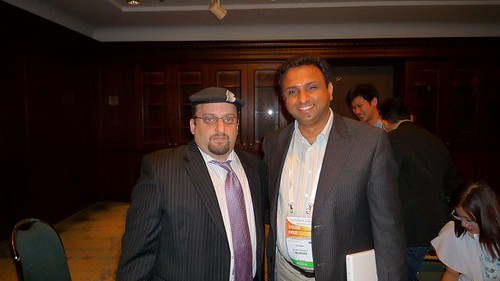Meeting Barrack Obama’s Digital Guru!
 I followed the Online Marketing initiatives of the US Presidential Elections, 2008, closely and also created a detailed presentation on my understanding of how the same can be replicated in India.
I followed the Online Marketing initiatives of the US Presidential Elections, 2008, closely and also created a detailed presentation on my understanding of how the same can be replicated in India.
This presentation deck was appreciated widely and has been downloaded by more than a thousand people in the last few months. (http://tr.im/gBiF)
I was indeed very impressed with the guys who were responsible for creating and executing this campaign- …Chris Hughes (25 year old co-founder of facebook). And Scott Goldstein (widely recognized as the Digital Guru of Obama)
Fortunately, Scott was coming over to speak at ad:tech Singapore and that’s where I had a chance to interact with him personally and learn more on how he created history.
Scott came across as a very unassuming and jolly good fellow to interact with, with no airs about running history’s largest mobile and social media campaign- I was ready to ask the man himself a few questions.
I have always thought that it’s one thing to engage people and it’s another thing to ask them to convert or do a favorable action, hence iI this case I have always wondered-how did Scott influence people to come out and vote? And how did he manage expectations of people?
Scott actually started off the Obama campaign in a very grounded and low profile way, his first priority was to let as many people, subscribe to his sms and multimedia updates, as possible (through iphone and blackberry apps among other modes).
He also harnessed social media and mobile technology to help people create clusters and communities at the ground level, and supported the people and communities through his team and volunteers, who would continuously answer each query in real time and in a personalized way through the use of SMS shortcodes, twitter etc.
So much so that, this entire ecosystem started to build onto itself, and engaged people at each step- coupled with peer emulation-it also influenced people to come out and vote.
This didn’t stop here- Scott’s team guided people on the location, direction and timings for voting, people who waited in the que had the facility to speak to or chat with a remote volunteer or with their peers nearby and it was seen that friends are helping those who are waiting in que, with foods and refreshments-Thanks to Goldstein’s mobile and web apps.
Net. Net, through the use of technology, Scott helped people communicate with each other and remain updated on the elections.
Scott was also the brain behind the 3am calls to people to update bout Joe Biden as a running mate to Obama, and this created immesne buzz across USA.
Both I and Scott agree that 2 things went very positively for Obama;
1. The entire campaign was interactive and 2 way. Other candidates also had a website and were also present on social networks- but Obama’s presence was more interactive, it allowed people to talk, and receive feedback.
2. Obama used technology to portray himself as a complete family man- his videos and images with his kids and wife touring constituencies were hugely popular on youtube., and created an incredible impact.
According to Scott, they didn’t start with 50 social networks, and they didn’t start with specific targets and numbers. They started with goals, and measured them periodically. Success bred success, and they applied layers of applications and technology to create a chain reaction of sorts.
In the end, we also agreed that while there was an unprecedented use of technology-if it was not Obama, the story could have been different. Obama has his own charm and everything right from his vision, to slogans, to the way he speaks, his family image, his photographs etc. were as important as the execution of his digital campaign.
Scott, now runs his own company-Revoloution-Messaging and helps companies adopt the same prinicples that were used in Obama’s campiagn.
Way to go Scottt!




